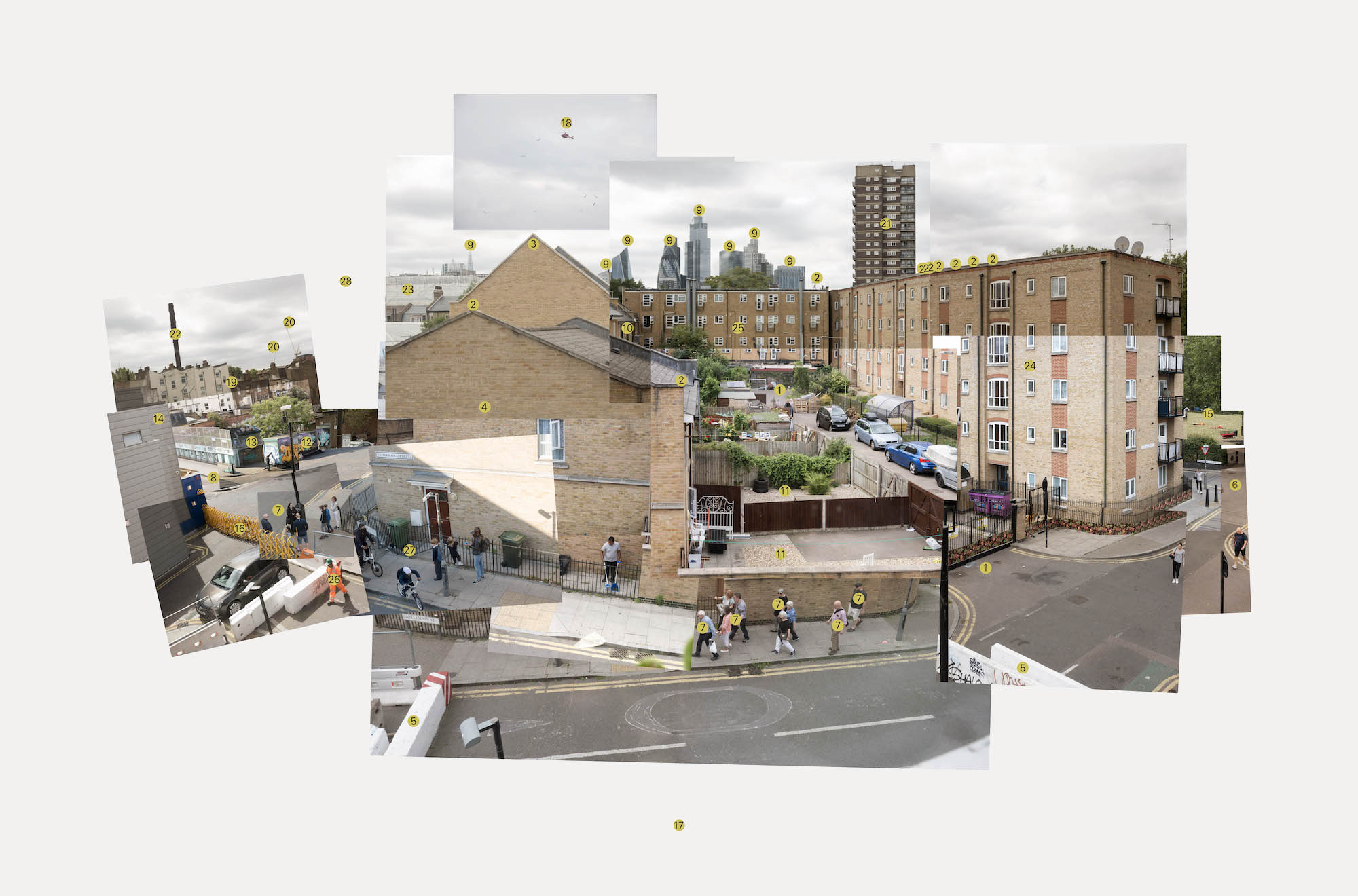
Perspective
View the above image at full-size in a new browser windowKey
- The gate on this cul-de-sac means that children can play safely. It’s both heartwarming to see and a saddening reminder of all the other children unable to do so because of the risk of being knocked down by a vehicle. In the summer months people chat, tend their plants and fix their bikes while kids scream in glee, kick footballs and ride their bikes up and down.
- Birds - magpies, seagulls and pigeons perch briefly before swooping off to who knows where.
- This is the most recent house on this terrace to have an extra top floor added, providing more space and a significant increase in resale value.
- The house on the end of the terrace was rented out, probably via Airbnb, to a diverse range of domestic and foreign visitors for a number of years. These short-term visitors sometimes looked disappointed at the spartan nature of their accommodation when they arrived and never stayed for long. The house is now rented to a family with young children, probably because of the Covid-19 pandemic’s impact on tourism.
- Crossrail’s concrete barriers serve as a place for men to talk after visiting the gym. Further along at the next barrier, drivers park their sports cars and stand talking or wander round admiring each others’ vehicles.
- Lookouts for drug dealers keep a watchful eye at this corner.
- Jack the Ripper tour guides pause here to point out the place where Mary Anne Nichols was murdered.
- Ten yards along this street Stalin, Lenin, Trotsky, Gorky and others passed through a door to attend the 1907 Russian Social Democratic Labour Party Congress.
- The City of London’s office towers have multiplied and risen ever higher over the first two decades of the new millenium.
- The houses on this terrace built by Tower Hamlets Community Housing, the largest local housing association, are now highly valuable due to their proximity to the City. They were built in 2002 and sold for shared ownership via invitations to apply to purchase.
- The two back gardens, that are visible from this vantage point, have been gravelled over and denuded of plants. This makes for cheaper maintenance for landlords.
- Some of Whitechapel market’s fruit and vegetable vans park on this street. They’re recognisable because of the graffiti that covers most of the vans’ surfaces. Some of the disassembled market stalls are stowed along here at night as well.
- The District and Hammersmith and City underground lines run along in a cutting behind this wall. On hot summer days there’s a sound like a helicopter taking off that suddenly stops at a certain pitch - it may be a train whose wheels are spinning as they try to gain traction on the curving track.
- The corner of the temporary Whitechapel station entrance juts out here like the dull grey prow of a navy frigate.
- In this small square, Crossrail workers lie in the sun, men sit or stand and talk, kids play in the little playground watched by their parents and the homeless gather in small groups. The space was formerly a Quaker burial ground.
- The gate where Crossrail lorries move in and out of the building site serving Whitechapel Station. Amongst the many economic forces that are acting on Whitechapel, this spot is probably the most acute.
- The block from which these photos were taken was built at the same time as 10. and 23. Of the eight flats, only one original tenant still lives in the block, two others are owner-occupied and the other five are privately rented.
- Red Air Ambulance helicopters regularly roar overhead on their way to and from the Royal London Hospital’s helipad.
- The back of a terrace whose front faces onto Whitechapel High Street. From the rear, many look like they’ve come out of a fight badly. Their facades are very different, having been renovated at government expense to appear respectable for the route of the 2012 London Olympics marathon. The route was changed after the renovation was completed and before the race was run.
- Cranes, ever-multiplying, indicators of the city’s inequality, ever-increasing.
- Council tower block showing no sign yet of gentrification or right-to-buy ownership. Incinerator chimey for the Royal London Hospital. The hospital’s construction was funded by private finance initiative at a cost of £1.2bn. The total eventual cost of repayment cost is currently estimated to be £6.2bn.
- Building adjacent to the site of the former Pavilion Theatre, at one time London’s principal Yiddish theatre, now being renovated by Spitalfields Trust.
- Housing association flats, rental only (10. and 17. likely to have financed this block).
- Private rental flats built on top of a row of shops.
- Crossrail worker identifiable by his hi-vis clothing. They have been a staple sight in Whitechapel for many years.
- In the mornings and afternoons the street sees a succession of parents taking their kids to and from the local schools.
- If you lean forward and listen closely at certain times of the day, you’ll hear the muezzin call to the faithful from the East London Mosque.

This work is licensed under a Creative Commons Attribution-NonCommercial-NoDerivatives 4.0 International License.